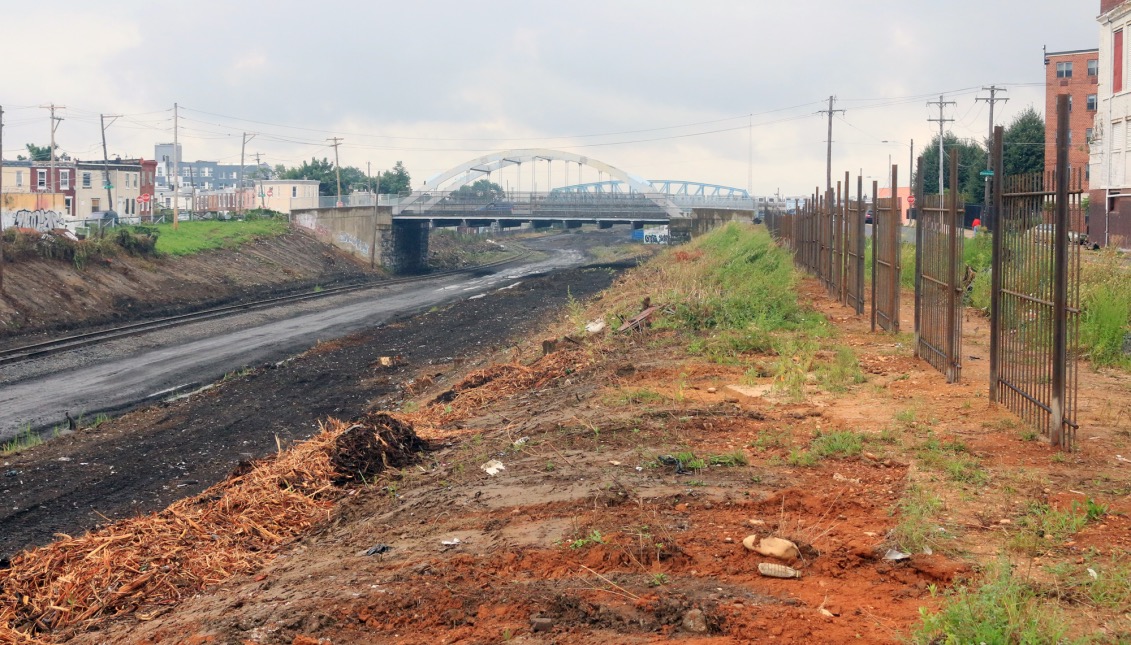
Displaced Destitute: The Aftermath of 'El Campamento'
With the cleanup of the tracks running along Gurney and Tusculum streets in full effect, former residents of the El Campamento site now look elsewhere for…
The tracks that hundreds of homeless people and addicts alike called home, nicknamed El Campamento, is officially no more. In a press release from August 10, the city stated that over 250 tons of debris, including syringes, couches, mattresses, and copious amounts of trash, have been removed from the area. The overgrown vegetation has been removed, with trees and bushes being torn from the roots and driven out in truck loads.
When Conrail and Philadelphia city officials came to El Campamento to evict the “residents” and commence the cleanup, they didn’t just force them to leave. Instead, the city set up what Alicia Taylor, communications director for the Health and Humans Services Cabinet, called a “Social Services Hub.”
“We had three trailers or RVs that were set up,” said Taylor. “[They were] doing testing and also screening to help folks, whether it was housing or they wanted an HIV test or they were interested in entering treatment.”

Out of the 141 individuals who reached out to the city for help at this site, 50 have sought out additional treatment. This is a sign to Taylor and other city officials that the cleanup has been a success thus far.
The city can’t force people to take advantage of the services they are offering, but instead just show people that they are there and hope that someone will take them up on their offer of aid.
Once the official clean up comes to a close and services being offered in the area are removed, the chance of another El Campamento is always possible. Once the vegetation grows back, blocking the public’s view of the tracks, who’s to say that addicts and homeless folks alike will not return back to their home underneath the bridges that cross the tracks? But Taylor states that the city will be out on the streets helping to combat their addiction.

“Our teams are out there, on the ground, every day,” said Taylor. “We still have outreach teams out there walking the streets talking to folks and trying to engage them and make them understand what services are out there and available to help them.”
One of the many individuals who took advantage of the city’s offer was Juan Rivera Serrano.
Serrano, who came to the United States from Puerto Rico with his wife in the early 2000’s, had been living on the tracks alongside other addicts. His preferred drugs of choice were cocaine and heroin.
When arriving in the States, Serrano stated that he used cocaine recreationally, but as time passed he continued to abuse the drug more and more. Eventually, he started using heroin. As his addiction worsened, Serrano discovered that his wife had been seeing another man. This caused him to hit rock bottom and his addiction to spiral out control. His addiction left him homeless, and with nowhere else to go, Serrano turned to El Campamento for a place to call home.
Asteria Vives, the founder of a community advocacy organization called Home Quarters and Friends, aided in translating Serrano’s experience living on the tracks in El Campamento.

“I didn’t have anywhere to go,” said Serrano, discussing his reasons for choosing to live on the tracks. At first, he enjoyed it. He was surrounded by others like him, giving him a sense of community and safety. Serrano even described it as “beautiful.” But as the days passed, that beauty faded.
RELATED CONTENT
During his time at El Campamento, Serrano suffered from a multitude of issues. He was unable to sleep. He was robbed. He was forced to search through dumpsters and trash cans for food, something he said he never imagined himself having to do.
With each day he spent down on the tracks and underneath the bridges of El Campamento, Serrano lost himself further to his addiction. The camp itself kept him from seeking out help and attempting to escape the situation he as in. That all changed once the cleanup began.
Serrano said that the officials leading the cleanup respected him and his fellow residents when they asked them to leave. Even though they treated him well, the real question he had on his mind was, “Where was I going to go next?”
Serrano took advantage of the services offered by the city. The officials at the Social Services Hub gave Serrano a check before sending him off to a hospital for future assistance. From there he was sent to a rehabilitation facility to begin his treatment. The road to recovery was grueling, but Serrano now had the self-motivation to succeed.
“I want to break my addiction. I want to go to detox,” said Serrano. “I want to live life again.”
Unfortunately, while going through detox, the doctor on staff at the center informed Serrano that he had liver cancer. Serrano was, obviously, shocked by this news.
Not only would he have to continue living on the streets while struggling to remain sober, he would now have to seek treatment for his cancer. Serrano has medical insurance that would allow him to get the necessary care he needs, but, due to his current situation, treatment may be more difficult to obtain.
After his first initial detox was over, Serrano had no place to go. He ended up living on the streets once more. Although he now sleeps in a cardboard box outside of a closed store, Serrano prefers it to living in El Campamento. He feels safer than before, and now has hope for his future and a desire to do better for himself and his family.
“I would love to see my family again,” said Serrano, whose parents live in Puerto Rico and who he hasn't seen since he arrived in the United States. “I would do any to see my family again. I just want to change my life entirely.”
Serrano’s drug use pushed him away from his family and loved ones. Reconnecting with his parents has aided Serrano, keeping away from drugs and helping to handle his depression. Serrano hopes to one day to return to Puerto Rico and reunite with his family. First, he must escape the streets of Kensington.
Vives promised to help a place for Serrano to continue his rehab treatment. She stated that if he agreed to follow through and work towards his sobriety, she would personally help him return home to Puerto Rico and unite with his parents.
According to Vives, Serrano is a great example of the positive outcome that came from the cleanup of El Campamento. Pushing the homeless and addicts out of a place they called home was more beneficial than they may realize. With the services that the city is offering, along with individuals like Vives and her organization, these displaced people can finally get some help.
“The cleanup was good because it allowed some of our drug users to have options,” said Vives. “Now you are out of that area. You’re out of that hole. You’re out of that corner. You’re out from underneath a bridge. Now, what would you like to do? We are here for you.”
With assistance from Vives and others like her, individuals like Serrano can beat their addiction and get away from the streets of Kensington, away from places like El Campamento, and change their lives for the better.










LEAVE A COMMENT: